Modern China (1911 AD ~)

About Modern China
This period in Chinese history presented enormous challenges for Chinese medicine. The rapidly changing political environment, combined with much foreign influence, altered perceptions of medicine generally. These perceptions both hindered and advanced the practice of Chinese medicine and led to the system that is current in China today, where Chinese and Western medicine are practiced side by side for the benefit of the patient.
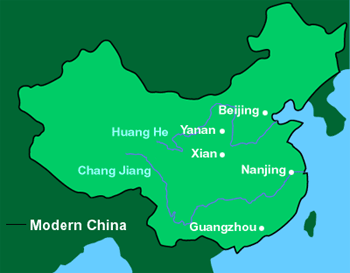
The 1911 Revolution to Mao Zedong and Communism
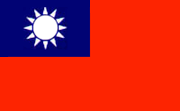
The Qing Dynasty finally collapsed in 1911 as a result of the might of the Kuomingtang, led by Sun Yatsen. A republic was formed in January 1912 and the capital moved from Beijing to Nanjing. However, the new government was unable to consolidate its power in China. Warlords (many of whom were part of the military under Sun Yatsen) reappeared and exerted rule in many small areas of the countryside. Foreign powers, such as the English, French and Americans, who had previously negotiated unfair trade deals under the Qing Dynasty, cheated China of her cultural heritage and further weakened her sovereignty. Their presence allowed Western concepts, especially those pertaining to medicine, to slowly pervade the country and by the 1900s Western ideas were embraced as a means to modernize the country. The practice of Western medicine was in large part brought to China in the 1800s by missionaries, who set up hospitals and dispensed Western medicines. The trade deals negotiated by these foreign countries protected the missionaries and fostered the spread of Western medicine.
Chiang Kaishek eventually reformed Sun Yatsen's government under the National People's Party. This new Kuomingtang (KMT) government came to power in Nanjing in 1927 and achieved a temporary unity in the country. The Chinese Communist Party, established in 1921, was the opposing political force during that time. In 1931, shortly after these two parties came into being, Japan invaded Manchuria and started a war that lasted eight years. These eight years of Japanese occupation had devastating effects for China.
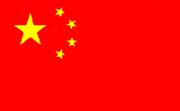 After the Japanese surrender, conflicts between the two political parties escalated into civil war. Mao Zedong led the People's Liberation Army against the KMT nationalists. Initially, Mao Zedong was forced to retreat to the Yanan area, but eventually he was successful in gaining control of the entire country, forcing Chiang Kaishek and his followers to retreat to Taiwan. In 1949, the People's Republic of China (PRC) was established with Mao Zedong as its chairman. The capital was moved back to Beijing. This time the government was able to achieve lasting unification of the country, although the Chinese people still faced much hardship.
After the Japanese surrender, conflicts between the two political parties escalated into civil war. Mao Zedong led the People's Liberation Army against the KMT nationalists. Initially, Mao Zedong was forced to retreat to the Yanan area, but eventually he was successful in gaining control of the entire country, forcing Chiang Kaishek and his followers to retreat to Taiwan. In 1949, the People's Republic of China (PRC) was established with Mao Zedong as its chairman. The capital was moved back to Beijing. This time the government was able to achieve lasting unification of the country, although the Chinese people still faced much hardship. The Health Problems of China and a Divergence from Chinese Medicine
In the first half of the 20th century, the health of the Chinese population suffered greatly. Epidemics were rampant and diseases such as cholera, plague, smallpox, black fever, diphtheria, scarlet fever, malaria, bilharzia and tuberculosis caused hundreds of thousands of deaths. People were further plagued with famines and unremitting starvation.
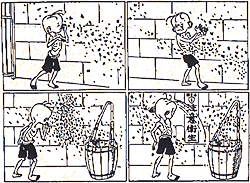
Perhaps it was as a result of these horrific conditions, combined with the changing political climate, that more emphasis was centered on public hygiene and government leaders began to show a preference for Western medicine over Traditional Chinese Medicine (TCM). More regulations for medical education were put in place and an increase in health centers staffed by Western and Japanese doctors was seen together with a surge in the numbers of professional medical associations and journals.
To some extent, Chinese medicine became a symbol of the old backward ways of doing things to those who wished to modernize China. Wang Daxie, who was the Minister of Education in Sun Yatsen's government, was one of the first officials to call for the abolition of Chinese medicine. Although he was not successful in this, the new nationalist Kuomingtang government adopted similar views about Chinese medicine. A proposal entitled "A Case for the Abolishment of the Old Medicine to Thoroughly Eliminate Public Health Obstacles," written by Yu Ai and Wang Qizang, suggested that important Chinese medicine principles, such as the yin yang theory and the five elements, were not based on reality and further intimated that Chinese medicine was fraudulent. The proposal, which was passed by the Central Ministry of Health in 1929, severely limited the advertising and practice of Chinese medicine. It also prohibited anyone from establishing Chinese medicine schools, so that the spread of "unscientific" information could be controlled.
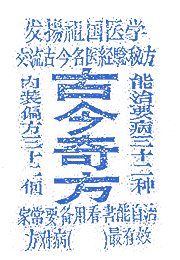
Even Mao Zedong, who was leading his Red Army in the Yanan area at the time, mirrored the Nationalist government sentiments. Both his army and the surrounding population were experiencing a shortage of food, shelter and clothing, and faced additional problems of illness due to poor hygiene and sanitation. This prompted him to instruct his army in 1942 to uproot all "shamanic beliefs and superstitions"5 and form model public health villages. Proper hygiene and sanitation remained of prime concern to him and like his nationalist counterparts he thought Chinese medicine doctors were no better than "circus entertainers, snake oil salesman or street hawkers."6
Despite all the negative sentiment about Chinese medicine during this period, its practice was impossible to eradicate. Yu Ai and Wan Qizang's proposal sparked heavy protest from the Chinese medicine communities. In March 1929, members of 132 TCM associations congregated in Shanghai and the National Union of Associations for Chinese Medicine was formed. From that day forward, March 17th was declared the birthday of Chinese medicine.
Integration and Modernization of Chinese Medicine
Despite the debate over official government policy and attitude, Chinese Medicine was still widely accepted and used among the common people, especially in the countryside where the majority of China's ballooning population lived. With the growth of Western medicine in China, many TCM physicians saw the benefit of assimilating it into TCM practice. As a result, a new school of thought, referred to as School of Sino-Western Convergence and Intercourse emerged. Important figures that followed this school of thought included Tang Zonghai and Zhang Binglin.
Of course, there were many other medical practitioners who thought that the best way of preserving Chinese medicine was to incorporate Western views into its practice. Other important figures such as Yun Tieqiao, Yang Zemin, Fu Lanyuan, Ding Ganren, Zhang Shanlei, Xie Liheng, He Lianchen and Qiu Jisheng also contributed to the advancement of Chinese medicine during this time.
Mao Zedong and Chinese Medicine
 When Mao Zedong, the Great Helmsman, drove the Kuomingtang out of China in 1949, the anti-Chinese medicine stance continued until after the Kuomingtang had fled into what is today known as Taiwan.
When Mao Zedong, the Great Helmsman, drove the Kuomingtang out of China in 1949, the anti-Chinese medicine stance continued until after the Kuomingtang had fled into what is today known as Taiwan. In 1942, Mao had ordered the government to banish all superstitious and shamanic beliefs from the Yanan region and to create public health villages. However, in the years between 1953 and 1959, well before the Cultural Revolution was launched, Mao reversed his anti-Chinese medicine stance. Chinese medicine was used as a symbol for China and considered a national treasure by the government.
Historically, these are the years when the leader was most hungry to gain power and influence in the communist world. During this period Russia, as the former Soviet Union, was quickly gaining global power and recognition. Russia was soon perceived as a threat and possible superpower alongside the United States. Mao was keen to create a form of communism that would put him and China in the spotlight among communist countries, and at the same time diminish China's growing reliance and dependency on the Soviets. (China actively depended on the Soviet Union for medical equipment and pharmaceutical drugs.) The kind of communism Mao set out to create focused on "patriotism," "being self reliant" and "native." Chinese medicine promoted this form of communism.
As a result, there was a revival of Chinese medicine during these years. In 1954, the Department of Chinese Medicine was established under the Ministry of Public Health (Oriental Medicine). Thanks to Mao's endorsement, institutions, such as the Shanghai College of TCM, Beijing College of TCM, Chengdu College of TCM, Guangzhou College of TCM and Nanjing College of TCM, were established. Leading by example, Mao himself would use a traditional Chinese medicine remedy called "Honeysuckle and Forsythia Powder" and allow two important TCM practitioners Li Shizhi and Peng Luxiang of the Chengdu College of TCM to be present at his bedside when he fell ill during a Great Leap Forward conference in Chengdu in 1957.
Mao's Policy of Integration of East and West Medicine
In 1958, at the beginning of Mao's Great Leap Forward campaign, the practice of Chinese medicine again experienced more changes. Mao revealed his vision of "integration of Eastern and Western medicine." His idea was to insert some of the rigor of modern science into Chinese medicine's future development. This led to a search for 2,000 Chinese physicians highly trained in Western medicine to attend special seminars dedicated to the study of Chinese medicine over a two-year period. Only about 200 physicians graduated from this program, a possible testament to the fact that the study of Chinese medicine was difficult. Many of these doctors became top administrators in the 1980s and 1990s, as China once again sought to open its doors to both Eastern and Western thought after the tumultuous years of the Cultural Revolution. Mao's integration policy also led to the establishment of TCM in in- and out-patient departments in hospitals and TCM education was restructured to include some Western medicine instruction. Many patients turned to TCM treatments when Western therapies were not successful.
The Cultural Revolution
The Cultural Revolution (1966∼1976) was used by Mao Zedong to try to regain power and influence in the political arena and he played on the sensitivities of the masses to achieve this. As a result, traditional culture, thinking and perspectives were crushed. Academics, professors, doctors and those who were well educated became targets of the campaign, while farmers, laborers and the uneducated gained power and influence during these years.
The purpose of the revolution is questioned to this day and is frequently debated, but the damages that it did to ordinary people and to higher education was extraordinary. The key word in this revolution was "reform" and Mao had specific views on how that reform would be acted out for healthcare. In a speech to healthcare professionals in Beijing on 26 June 1965, he stressed the need to reform medical education: "It is completely unnecessary to engage in so much studying. How many years of formal education, after all, did Hua Tuo (141∼208 AD) have? And how many Li Shizhen. There is no need to restrict medical education to people with high school diplomas; middle school and elementary school pupils studying for three years will do. If this type of lowly educated doctor is then sent to the countryside, he will always be able to do a better job than the charlatan shamans; and the peasants, moreover, will be able to afford such care." Mao ended the speech with this bluntly stated viewpoint: "Studying is a stupid endeavor for a doctor."7
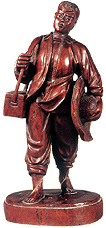
Consequently, the old medical curriculum was buried and the most revered medical practitioners were killed, imprisoned or sent to indoctrination camps for their "traditional" ways of thinking. The doors of learning were now opened to workers, peasants, soldiers and other members of the under-privileged classes. Entrance exams were scrapped, admission was based on family background and political status, and textbooks were filled with quotes from Mao's collected works and "little red book." Those passing through this system received minimal training in Western and Chinese medicine. This movement provided the bulk of the "barefoot doctors," who had very limited medical knowledge, but served a major role in addressing medical needs in the countryside. In fact, the barefoot doctors had already begun to emerge in the 1950s and most were young villagers. Their importance cannot be under-estimated since they attended the needs of a nation where over 90 per cent of the population lived in the countryside. By 1984, there were some 1.28 million barefoot doctors practicing in China.
Chinese medicine practitioners also suffered greatly under this movement. One prominent leader in Chinese medicine, Ren Yingqiu, was banished to the Qing Hai Province (an area likened to Siberia) and was allowed to bring only one book. This was Li Shizen's Compendium of Materia Medica. The class of 1963 was the last class to complete a full TCM curriculum. No students were admitted into Chinese medicine schools during the years between 1965 and 1970.
After the Cultural Revolution was officially ended in 1976 with the death of Mao, academics, artists, professionals, and TCM and Western physicians slowly re-emerged into society.
Modern Chinese Research and Development
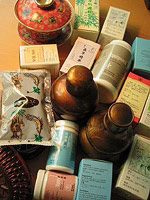 Despite the problems that were faced by Chinese medicine during the 20th century, research was carried out not only in Western medicine, but also in the use of Chinese medicinal herbs and many technological advances were made. As early as the 1920s, pharmaceutical research in China became more systematic. This was due to the influence of graduates from European, American and Japanese universities who applied their scientific knowledge in Chinese laboratories. During the 1930s and 1940s, the Central Research Institute, the Beijing Research Institute and the Central Laboratory of Hygiene focused on the therapeutic quality of plants such as Sichuan lovage, plantain seed, pinellia tuber, rehmannia root, pilose asiabell root and, in particular, the antifebrile dichroa root, which had been traditionally used to combat malaria. Chemical, clinical, pharmacological and parasitological research further validated the use of this plant as an antimalarial agent. Naturally, these research activities generated a variety of publications describing the application of traditional herbs in modern medicine. One of the most important of these was the Chinese Pharmaceutical Encyclopedia (zhong guo yao xue da ci dian), which was published by Chen Cunren in the early 1930s.
Despite the problems that were faced by Chinese medicine during the 20th century, research was carried out not only in Western medicine, but also in the use of Chinese medicinal herbs and many technological advances were made. As early as the 1920s, pharmaceutical research in China became more systematic. This was due to the influence of graduates from European, American and Japanese universities who applied their scientific knowledge in Chinese laboratories. During the 1930s and 1940s, the Central Research Institute, the Beijing Research Institute and the Central Laboratory of Hygiene focused on the therapeutic quality of plants such as Sichuan lovage, plantain seed, pinellia tuber, rehmannia root, pilose asiabell root and, in particular, the antifebrile dichroa root, which had been traditionally used to combat malaria. Chemical, clinical, pharmacological and parasitological research further validated the use of this plant as an antimalarial agent. Naturally, these research activities generated a variety of publications describing the application of traditional herbs in modern medicine. One of the most important of these was the Chinese Pharmaceutical Encyclopedia (zhong guo yao xue da ci dian), which was published by Chen Cunren in the early 1930s. After the People's Republic of China was founded, the preservation of China's traditional herbs became a priority. There are an estimated 4,000∼5,000 medicinal herbs growing in China of which 1,000 are commonly used. Measures have been taken to research their optimal growing conditions and to stimulate production. Some herbs are now grown systematically on plantations, as opposed to forest collection, with many of the large-scale enterprises following good agricultural practice (GAP). Other advancements made in the last century include modification of the dosage forms. Chinese medicine is now available not only as traditional decoctions, but also in the form of pills, tablets, capsules, granules, suppositories, creams, lotions and suspensions. This provides a more accessible and user-friendly form of medication. Other Chinese medicines are prepared for intravenous use in hospitals.
Some notable achievements which have resulted from the combination of Eastern and Western medicine during this century include the setting of fractures with mobile willow twig splints after determining the nature of the break using X-rays; the use of acupuncture anesthesia during surgery; and the performance of taijiquan (better known as tai-chi, a traditional exercise) to build up the body's immunity and help prevent certain chronic illnesses.
Chinese Medicine Today
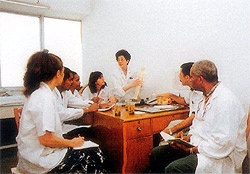 Today, medicine in China focuses very much on integration, seeking a fusion of East and West. The challenge is to extract the best from both systems to maximize the benefit for the patient. Health statistics have shown that the practice of both Western medicine and TCM has grown rapidly. According to the 1991 Chinese Health Statistical Digest, the number of Western-trained doctors soared from 3,800 in 1949 to 1.1 million in 1991; and over the same period, the number of doctors practicing TCM rose from 27,600 to 362,600. The number of hospital beds provided for both systems has also risen. Hospital beds available for TCM increased from a mere 220 in 1949 to 188,200 in 1991, while those for Western medicine rose from 84,400 to 836,360. A three-tiered system - a blend of TCM, Western and integrated medicine - has emerged which offers patients better healthcare choices than any one of the systems alone. As Chinese medicine gains more popularity in the West, China will continue to move forward with research and education. This will further TCM's development and practice and serve as an important resource for those who wish to share in its bountiful benefits.
Today, medicine in China focuses very much on integration, seeking a fusion of East and West. The challenge is to extract the best from both systems to maximize the benefit for the patient. Health statistics have shown that the practice of both Western medicine and TCM has grown rapidly. According to the 1991 Chinese Health Statistical Digest, the number of Western-trained doctors soared from 3,800 in 1949 to 1.1 million in 1991; and over the same period, the number of doctors practicing TCM rose from 27,600 to 362,600. The number of hospital beds provided for both systems has also risen. Hospital beds available for TCM increased from a mere 220 in 1949 to 188,200 in 1991, while those for Western medicine rose from 84,400 to 836,360. A three-tiered system - a blend of TCM, Western and integrated medicine - has emerged which offers patients better healthcare choices than any one of the systems alone. As Chinese medicine gains more popularity in the West, China will continue to move forward with research and education. This will further TCM's development and practice and serve as an important resource for those who wish to share in its bountiful benefits.

